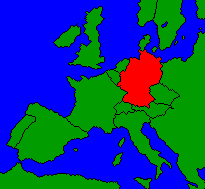

Seventeenth Century Germany
|
IntroductionOrgan building in Germany before the seventeenth century was a highly active business, and instruments built throughout were among the largest and most impressive in all of Europe. The Protestant Reformation, which had in England practically stopped the use of organs in worship, had the effect in Germany of providing new outlets for musical expression. By the end of the sixteenth century, German chorales had formed a body of liturgical song that allowed composers to use a melodic line as a cantus firmus and know that the listener would understand the expressive content of the music through the text associateed with the melody. German organists then were free to improvise on these familar melodies during services, forming the basis of organ chorale compositions for the next several centuries. Throughout the sixteenth and seventeenth centuries, possession of a fine organ was seen as fitting not only for churches, but for nobility as well. Rivalries that existed between various cites, between different members of the nobility, and even between different churches and religious institutions lead to situations in which having a major musical establishment was a status symbol that was highly prized by many. We are fortunate that their sense of competition chose the organ to be a focus of their rivalry. Around 1600 major organ-building centers were found from the northwest to the southern borders of Austria, and we can read the 1511 treatise of Arnolt Schlick as a predictor of the interest the organ was to have by the end of the century.147 The German organ -- of whatever region -- had acheived a status which it has never lost. The first half of the seventeenth century was a difficult time for Germany. The Thirty Years War (1618-1648) was fought for the most part on German soil, and at times different German Princes were supported by or at war with the Dutch, the Swedes, the French, the Spanish, and the Holy Roman Empire. To say that "the War caused disruption in organ building in all regions of Germany" is perhaps so much an understatement that it needn't be said. However, for us, at a distance of almost 400 years and several thousand miles, it's good to be reminded not only of the Thirty Years War, but also of the fragmented political divisions in Germany for most of its history. At the beginning of the seventeenth century, the political, religious and economic distinctions that existed among the various regions of Germany reached the boiling point, and all-out war was the result. In the second half of the century, peace was restored, the economy stabilized, and -- of greatest importance to us in our study -- organ-building resumed apace. Regional distinctions within Germany meant that both before and after the disruption of the War, organs there lacked the unity of design and purpose that we find in France after 1650. The study of different types of instruments throughout all German-speaking lands (including Austria and Switzerland) in the seventeenth century alone would be a major undertaking for an undergraduate today.148 This tutorial concentrates on a limited number of topics:
|
| Review Quiz |
© 2000 James H. Cook